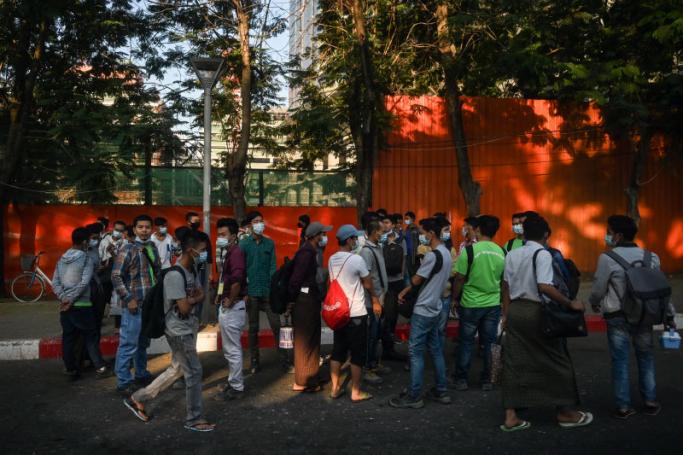The Asian Development Bank (ADB) this week released growth outlook projections suggesting that—whilst the ravages of the COVID-19 Delta variant are expected to cut predicted GDP growth for the region by an aggregate of one percent—the impact of Myanmar’s military coup compounded by the pandemic’s third wave will see Myanmar’s GDP shrink by 18.4 percent — an almost 27 percent year-on-year decrease in the ADB’s prediction for Myanmar’s economic activity.
Shortly after the coup, the World Bank also predicted an 18 percent contraction of Myanmar’s GDP. In March, the ADB placed a temporary hold on sovereign project disbursements and new contracts in Myanmar. However, bank representatives recently attended the Greater Mekong Subregion Summit alongside China, junta head Min Aung Hlaing, and a host of ASEAN nation ministers.
Myanmar is just one of a number of Asian countries rattled by the lowered 2021 growth outlook amid the continuing concerns over the COVID-19 pandemic.
Overall, the ADB forecasts Asian economic growth of 7.1% this year, according to an update of its flagship economic publication, Asian Development Outlook (ADO) 2021. That compares with a projection of 7.3% in April. The growth outlook for 2022 is raised to 5.4% from 5.3%. New COVID-19 variants, renewed local outbreaks, the reinstatement of various levels of restrictions and lockdowns, and slow and uneven vaccine rollouts are reportedly weighing down the region’s prospects.
“Developing Asia remains vulnerable to the COVID-19 pandemic, as new variants spark outbreaks, leading to renewed restrictions on mobility in some economies,” said ADB Acting Chief Economist Joseph Zveglich, Jr. “Policy measures should not only focus on containment and vaccination, but also on continuing support to firms and households and reorienting sectors in the economy to adapt to a ‘new normal’ once the pandemic subsides to kickstart the recovery.”
COVID-19 cases in developing countries in Asia like Myanmar have risen since the Delta variant of the virus emerged in April. New daily cases peaked at 430,000 in May. More than 163,000 new daily cases were recorded on 31 August. Meanwhile, vaccination progress in developing Asia remains uneven and lags behind that of advanced economies. As of 31 August 2021, 28.7% of the region’s population had full vaccine protection, compared with 51.8% coverage in the United States and 58.0% in the European Union.
The recovery path within the region remains uneven. East Asia’s growth forecast for this year has been raised to 7.6% from 7.4% in April, as a surge in global demand fuels exports from the region. East Asia’s growth prospects for 2022 are unchanged at 5.1%. Growth projections for the People’s Republic of China, the region’s largest economy, remain at 8.1% in 2021 and 5.5% in 2022.
The economic growth outlook for Central Asian economies this year is raised to 4.1% from 3.4% projected in April, amid improved prospects for Armenia, Azerbaijan, Georgia, Kazakhstan, and Uzbekistan. The subregion’s 2022 outlook has improved to 4.2% from 4.0%.
ADB expects economic growth of 8.8% in South Asia this year, compared with the 9.5% forecast in April for the subregion. However, the outlook for 2022 has improved to 7.0% from 6.6%. The projection for India—the subregion’s largest economy—is downgraded to 10.0% from 11.0% in 2021, while the outlook for next year has improved to 7.5% from 7.0%.
The forecasts for Southeast Asia and the Pacific have also been revised downward, as economies in these subregions continue to grapple with new virus variants, continued lockdowns and restrictions, and slow vaccine rollouts. Southeast Asia’s growth projections for 2021 and 2022 have been lowered to 3.1% and 5.0%, respectively, from forecasts of 4.4% and 5.1% in April. The Pacific’s economy is set to contract 0.6% this year, compared with 1.4% growth projected in April, before expanding 4.8% in 2022.
The ADB reports says inflation in developing Asia is expected to remain in check, at 2.2% this year and 2.7% in 2022. The current trend of higher international commodity and food prices could stoke inflation in some of the region’s economies.
ADB says it is committed to achieving a prosperous, inclusive, resilient, and sustainable Asia and the Pacific, while sustaining its efforts to eradicate extreme poverty. Established in 1966, it is owned by 68 members—49 from the region.












